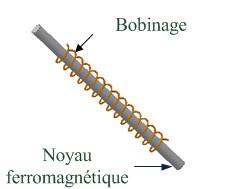Engineering:Search coil magnetometer
The search coil magnetometer or induction magnetometer, based on an inductive sensor (also known as inductive loop and inductive coil), is a magnetometer which measures the varying magnetic flux. An inductive sensor connected to a conditioning electronic circuit constitutes a search coil magnetometer. It is a vector magnetometer which can measure one or more components of the magnetic field. A classical configuration uses three orthogonal inductive sensors. The search-coil magnetometer can measure magnetic field from mHz up to hundreds of MHz.
Principle
The inductive sensor is based on Faraday's law of induction. The temporal variation of the magnetic flux [math]\displaystyle{ \Phi }[/math] through a N turns circuit will induce a voltage [math]\displaystyle{ e }[/math] which follows
- [math]\displaystyle{ e = - N\frac{\mathrm d \Phi}{\mathrm dt} }[/math]
which can be expressed in a simpler way
- [math]\displaystyle{ e = - N S\frac{\mathrm dB}{\mathrm dt} }[/math]
by assuming that the induced magnetic field B is homogeneous over a surface S (the magnetic flux will be expressed [math]\displaystyle{ \Phi = B \times S }[/math]).
The induced voltage ([math]\displaystyle{ e }[/math]) may be increased several ways:
- increase the surface (S),
- increase the turn number (N),
- use a ferromagnetic core.
Search coil using a ferromagnetic core
When a coil is wound around a ferromagnetic core, that increases the sensitivity of the sensor thanks to the apparent permeability of the ferromagnetic core.
Apparent permeability
The magnetic amplification, known as apparent permeability [math]\displaystyle{ \mu_{app} }[/math], is the result of the magnetization of the ferromagnetic core response to an external magnetic field. The magnetization is reduced by the demagnetizing field.
- [math]\displaystyle{ \mu_{app} = \frac{\mu_r}{1 + N_z (\mu_r - 1)} }[/math]
where [math]\displaystyle{ \mu_r }[/math] is the relative permeability, [math]\displaystyle{ N_z }[/math] is the demagnetizing coefficient in the z direction.
The induced voltage will be written
- [math]\displaystyle{ -Ne = NS\mu_{app}\frac{N\mathrm dB}{\mathrm dt} }[/math]
The demagnetizing coefficient can easily be computed in the case of simple shapes (spheres and ellipsoids).
Applications
- Eye tracker: a search coil is used to measure eye movement using coils that are embedded into a contact lens.
- Education
- Non-destructive testing
- Magnetotellurics
- Space research
- Natural electromagnetic waves observations on Earth.
References
- Pavel Ripka, Magnetic Sensors and Magnetometers, Artech House Publishers
- S. Tumanski, Induction Coil Sensors - a Review
- [1]
See also
- Waves (Juno) (Uses a magnetic search coil)
 |


